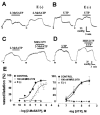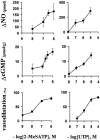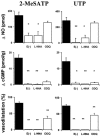P2Y(1) and P2Y(2) receptors are coupled to the NO/cGMP pathway to vasodilate the rat arterial mesenteric bed
- PMID: 12110609
- PMCID: PMC1573418
- DOI: 10.1038/sj.bjp.0704789
P2Y(1) and P2Y(2) receptors are coupled to the NO/cGMP pathway to vasodilate the rat arterial mesenteric bed
Abstract
1. To assess the role of nucleotide receptors in endothelial-smooth muscle signalling, changes in perfusion pressure of the rat arterial mesenteric bed, the luminal output of nitric oxide (NO) and guanosine 3',5' cyclic monophosphate (cGMP) accumulation were measured after the perfusion of nucleotides. 2. The rank order of potency of ATP and analogues in causing relaxation of precontracted mesenteries was: 2-MeSADP=2-MeSATP>ADP>ATP=UDP=UTP>adenosine. The vasodilatation was coupled to a concentration-dependent rise in NO and cGMP production. MRS 2179 selectively blocked the 2-MeSATP-induced vasodilatation, the NO surge and the cGMP accumulation, but not the UTP or ATP vasorelaxation. 3. mRNA encoding for P2Y(1), P2Y(2) and P2Y(6) receptors, but not the P2Y(4) receptor, was detected in intact mesenteries by RT-PCR. After endothelium removal, only P2Y(6) mRNA was found. 4. Endothelium removal or blockade of NO synthase obliterated the nucleotides-induced dilatation, the NO rise and cGMP accumulation. Furthermore, 2-MeSATP, ATP, UTP and UDP contracted endothelium-denuded mesenteries, revealing additional muscular P2Y and P2X receptors. 5. Blockade of soluble guanylyl cyclase reduced the 2-MeSATP and UTP-induced vasodilatation and the accumulation of cGMP without interfering with NO production. 6. Blockade of phosphodiesterases with IBMX increased 15-20 fold the 2-MeSATP and UTP-induced rise in cGMP; sildenafil only doubled the cGMP accumulation. A linear correlation between the rise in NO and cGMP was found. 7. Endothelial P2Y(1) and P2Y(2) receptors coupled to the NO/cGMP cascade suggest that extracellular nucleotides are involved in endothelial-smooth muscle signalling. Additional muscular P2Y and P2X receptors highlight the physiology of nucleotides in vascular regulation.
British Journal of Pharmacology (2002) 136, 847-856
Figures







Similar articles
-
P2X receptors counteract the vasodilatory effects of endothelium derived hyperpolarising factor.Eur J Pharmacol. 2000 Feb 25;390(1-2):173-80. doi: 10.1016/s0014-2999(00)00010-8. Eur J Pharmacol. 2000. PMID: 10708721
-
P2Y1 and P2Y2 receptor distribution varies along the human placental vascular tree: role of nucleotides in vascular tone regulation.J Physiol. 2006 Jun 1;573(Pt 2):427-43. doi: 10.1113/jphysiol.2006.105882. Epub 2006 Mar 16. J Physiol. 2006. PMID: 16543271 Free PMC article.
-
Relative contribution of P2U- and P2Y-purinoceptors to endothelium-dependent vasodilatation in the golden hamster isolated mesenteric arterial bed.Br J Pharmacol. 1996 Apr;117(8):1797-802. doi: 10.1111/j.1476-5381.1996.tb15357.x. Br J Pharmacol. 1996. PMID: 8732294 Free PMC article.
-
Molecular pharmacology of P2Y-receptors.Naunyn Schmiedebergs Arch Pharmacol. 2000 Nov;362(4-5):310-23. doi: 10.1007/s002100000310. Naunyn Schmiedebergs Arch Pharmacol. 2000. PMID: 11111826 Review.
-
Pharmacological profiles of cloned mammalian P2Y-receptor subtypes.Pharmacol Ther. 2006 Jun;110(3):415-32. doi: 10.1016/j.pharmthera.2005.08.014. Epub 2005 Oct 28. Pharmacol Ther. 2006. PMID: 16257449 Review.
Cited by
-
Reactive oxygen species contribute to the presynaptic action of extracellular ATP at the frog neuromuscular junction.J Physiol. 2005 May 15;565(Pt 1):229-42. doi: 10.1113/jphysiol.2005.084186. Epub 2005 Mar 17. J Physiol. 2005. PMID: 15774519 Free PMC article.
-
P2Y₁ and P2Y₁₂ receptors in hypoxia- and adenosine diphosphate-induced pulmonary vasoconstriction in vivo in the pig.Eur J Appl Physiol. 2014 Sep;114(9):1995-2006. doi: 10.1007/s00421-014-2921-y. Epub 2014 Jun 15. Eur J Appl Physiol. 2014. PMID: 24929904
-
International Union of Pharmacology LVIII: update on the P2Y G protein-coupled nucleotide receptors: from molecular mechanisms and pathophysiology to therapy.Pharmacol Rev. 2006 Sep;58(3):281-341. doi: 10.1124/pr.58.3.3. Pharmacol Rev. 2006. PMID: 16968944 Free PMC article. Review.
-
The Pleiotropic Role of Extracellular ATP in Myocardial Remodelling.Molecules. 2023 Feb 23;28(5):2102. doi: 10.3390/molecules28052102. Molecules. 2023. PMID: 36903347 Free PMC article. Review.
-
Mechanism of purinergic activation of endothelial nitric oxide synthase in endothelial cells.Circulation. 2009 Feb 17;119(6):871-9. doi: 10.1161/CIRCULATIONAHA.108.764571. Epub 2009 Feb 2. Circulation. 2009. PMID: 19188511 Free PMC article.
References
-
- ADRIAN K., BERNHARD M.K., BREITINGER H., OGILVIE A. Expression of purinergic receptors (ionotropic P2X1-7 and metabotropic P2Y1-11) during myeloid differentiation of HL60 cells. Biochim. Biophys. Acta. 2000;1492:127–138. - PubMed
-
- ANDERSON C.M., PARKINSON F.E. Potential signalling roles for UTP and UDP: sources, regulation and release of uracil nucleotides. TiPS. 1997;18:387–392. - PubMed
-
- BALLARD S.A., GINGELL C.J., TANG K., TURNER L.A., PRICE M.E., NAYLOR A.M. Effects of sildenafil on the relaxation of human corpus cavernosum tissue in vitro and on the activities of cyclic nucleotide phosphodiesterase isozyme. J. Urol. 1998;159:2164–2171. - PubMed
-
- BOARDER M.R., HOURANI S.M. The regulation of vascular function by P2 receptors: multiple sites and multiple receptors. Trends. Pharmacol. Sci. 1998;19:99–107. - PubMed
-
- BORIC M.P., FIGUEROA X.F., DONOSO M.V., PAREDES A., POBLETE I., HUIDOBRO-TORO J.P. Rise in endothelium-derived NO after stimulation of rat perivascular sympathetic mesenteric nerves. Am. J. Physiol. 1999;277:H1027–1035. - PubMed
Publication types
MeSH terms
Substances
LinkOut - more resources
Full Text Sources
Molecular Biology Databases

